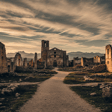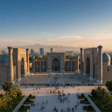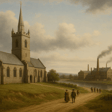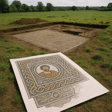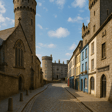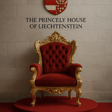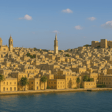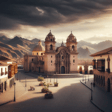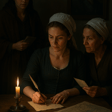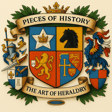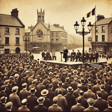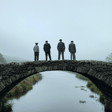Introduction to 'Pieces of History' and the Slave Wrecks Project
00:00:13
Speaker
Hello and welcome to Pieces of History. I'm Colin McGrath and in each episode i explore both the renowned and the lesser known events that have shaped our world. Today we turn our attention to a remarkable effort in maritime archaeology, the Slave Wrecks Project.
00:00:29
Speaker
This groundbreaking initiative seeks to uncover, document and study shipwrecks tied to the transatlantic slave trade, shedding new light on one of history's darkest chapters. To guide us through this fascinating topic, I'm joined by Dr. Steve Lubachmann, Maritime Archaeologist, Anthropologist and one of the founding members of the Slave Wrecks Project.
00:00:49
Speaker
In this episode we'll discuss Dr Lubachmann's academic background and how his expertise informs the project's approach. We'll explore the origins of the slave wrecks project, the methodologies used to locate and study these wrecks, and the significance of these discoveries in understanding the human stories behind the transatlantic slave trade.
Dr. Steve Lubachmann's Journey into Maritime Archaeology
00:01:07
Speaker
From advanced underwater survey techniques to the challenges of working in often remote and politically complex regions, Dr Lubachmann provides expert insight into the process of uncovering history beneath the waves.
00:01:18
Speaker
I hope you enjoy. so Steve, thanks very much for joining me. I really appreciate to you taking the time out of your um busy schedule. Do you mind starting things off by giving me a background to your academic journey, essentially what the Slave Wrecks project is and how you got involved?
00:01:34
Speaker
Sure. ah So ah sort of my own involvement in maritime archaeology is is kind of, I guess the best way to describe it would be through a back door. um So I was a um a graduate student ah doing work ah in cultural anthropology ah with a focus on sort of historical anthropology in southern Africa, ah Mozambique, and Angola, and so interested in ah both the period that came immediately after ah enslavement where there was colonial labor regimes and so forth, um you know, during the period when the Portuguese were in control of Mozambican Angola.
Origins and Early Challenges of the Slave Wrecks Project
00:02:16
Speaker
And ah I happened to be in the program at Brown University. ah where the archaeologist, one of the archaeologists there, Dr. Richard Gould, ah taught maritime archaeology. And as you probably know, there aren't that many maritime archaeology programs.
00:02:33
Speaker
And one of my colleagues who was doing his doctoral ah work, who came in in the same cohort, ah Dr. David Conlon, ah He needed somebody to come down at the time and do work in Florida on a shipwreck that was going to be his master's thesis.
00:02:51
Speaker
And he needed somebody who could draw and who could dive. And I happened to be free. And I ended up going down there. And, you know, it was ah learning yeah know sort of in the field and, of course, then taking additional courses. um But actually, um you know, I finished my doctorate as a cultural anthropologist.
00:03:12
Speaker
um But ah every summer, um Dick Gould would have a project and somebody who was doing a master's or a or a doctoral thesis, and they would need somebody to come along and work. and And I think ah probably six years into that, Dick was running a field school in Bermuda.
00:03:32
Speaker
And Donna Souza, who was one of his doctoral students, was the person who was his assistant. And then her husband got sick and she had to leave. And then Dick got sick and he had to leave.
00:03:44
Speaker
And I was the last man standing. And, you know, I had by that time probably seven years of experience. And and so I never planned to be doing maritime archaeology. But, ah you know, for the last 25 years, it's been one of the two major things that I ah that I do.
Identifying and Studying Slave Trade Shipwrecks
00:04:03
Speaker
ah And the, you know, the um the Slave Wrecks Project ah really emerged out of, again, sort of an unusual story.
00:04:14
Speaker
At the time, i was doing fieldwork in Mozambique, not necessarily archaeological. uh but um located a beach rec and went to the archaeology department there and said who does work on this uh and really there was no one there was somebody who was interested dr ricardo teixeira duart so we started up a conversation ah and were interested in doing work and i continue to to be interested in doing work in the indian ocean um But at that time, i also met um Dave and I continue to be in conversation, a colleague from South Africa at the Ezeko Museums of South Africa, Yakub Boshoff.
00:04:52
Speaker
ah And all three of us ah began to discuss and had had, you know, what is the field doing ah to take a look at this question of the slave trade? ah And it was it was astounding. I mean, this was in two thousand this is around 2001, 2002, and it was just a glaring omission.
00:05:13
Speaker
You know, I i sort of used this phrase that there were sort of more studies of cogs and bogs um than there were, um ah you know, efforts to locate and document ships from the slave trade.
00:05:26
Speaker
And this despite the fact that, for example, at that time, the Trans-Ellenic slave database, which has ah I'm sorry, so slave trade database, ah which had been started by Eltis and others, they had already documented something like 20,000 voyages. And now it's you more than triple that, I believe.
00:05:46
Speaker
and including many shipwrecks. But there was there was nobody that was looking at this question in a systematic
Ford Foundation's Support and Methodology Development
00:05:54
Speaker
way. There had been a few. The Friedensberg and the Henrietta Marie had been located by effectively Salvers, treasure hunters, um you know and had been sort of investigated as sort of curiosities.
00:06:09
Speaker
ah But nobody was taking this subject up. And it just seemed to speak volumes to you know enormous gap. There's probably, yeah know arguably, this is one of the you know processes that builds, historical processes that builds modernity.
00:06:27
Speaker
um One of the the most, if not the most important, that was maritime mediated. ah And the fact that the field was not looking at it ah said something sort of rather astounding about the field.
00:06:40
Speaker
And so we said, ah you know, this is this is something that we ah would like to ah you put our heads together, the three of us. There was another colleague of ours, John Gribble. ah And, you know, we put together a concept note at the time sort of focusing on possibilities that we had identified from archival and secondary sources in South Africa and Mozambique.
00:07:03
Speaker
And, um yeah you know, and went and began to look for support to do this work. And, you we heard crickets for years you know there was no interest in this um from any major agency until finally we had actually uh put this before the ford foundation in south africa and um alice brown who was the uh the program officer there um was very interested you know didn't have sort of the the operational latitude and
00:07:38
Speaker
I believe it was in 2008, all of a sudden called us up and said, i you know i think she said, I had funding that fell through on one thing. I need to use this funding. ah you know And we had ah been shopping that concept note around for five years, maybe.
00:07:54
Speaker
And so that's the origins. you know the That got the project kickstarted. um and our focus was in south africa and um i think four years later um as that um as that grant was ending we um met with uh colleagues i met colleagues uh colleague from the then he was at the smithsonian john franklin in tanzania who later introduced me to the current co-director with me of the project paul gardulo at smithsonian and then to
00:08:26
Speaker
um then the founding director of the Smithsonian, ah Lonnie Bunch. He's now the secretary of the Smithsonian. And, um ah you know, the the project um sort of grew from there. Right. So kind of a long and torture story, but...
00:08:44
Speaker
But, yeah, my way in was not um as direct as some. But, um you know, the the the interest in the subject matter, it's it's ah it's great to see much more interest in it now ah than there was, you know, for the years where we were sort of wandering around and looking for, you know, people who might be interested and think this was important.
00:09:06
Speaker
I thought it would have been so a particular area, you know, really of interest to the Smithsonian and a lot of those institutions maybe decades ago. Obviously, it wasn't, which I found very strange. And like you said, like roughly, did you say there's maybe 20,000, 40,000 possible ships that went back and forth over the over the centuries, essentially, Steve? And it's only really, what, 50?
00:09:29
Speaker
15 years ago, its this has really kicked off. but It just seems like a massive blind spot that, you know, this happened.
Community Involvement and Site Protection
00:09:37
Speaker
So if we can start from the the start, that the project was able to, you got some funding, you're obviously obviously able to kick things off.
00:09:44
Speaker
What were the steps then to obviously get people involved, like you've got yourself, like underwater archaeologists, you've got divers, you've got people removed like from Mozambique, from South Africa as well. How did you target the first wreck and what were the steps to to go around salvaging that or going down to dive to look at it?
00:10:02
Speaker
David Olusoga, Ph.D.: Sure, I mean I think so there were there were a couple things one is from the very from the very beginning, were interested, know, I think this may be sort of an artifact of having started project in Africa with with folks like yako and myself who had been.
00:10:21
Speaker
working in various different types of contexts and in ah in Africa for over a decade. ah In his case, he he grew up in South Africa. um I think we were we were very ah we were concerned with trying to do the um and do it in a way but that that sort of met certain requirements. So the first thing was um in both Mozambique and South Africa and everywhere, we so we have sort of the plague of treasure hunting.
00:10:52
Speaker
And so how do we address that, right? How do we offer a viable alternative to that? ah And so we were, you know, we, and probably in almost every theater that we've worked, we've we've encountered that issue.
00:11:06
Speaker
um At the same time, we were very keenly aware that we're working in contexts ah in which this um this kind of work needs to be relevant at a local level right so you know if you're working in mozambique that has all sorts of ah You know, this was not long after a Civil War or in post-apartheid South Africa.
00:11:32
Speaker
You know, there there's are very significant challenges. why should um Why should any resources be used on this and not um on necessarily other things? And so I think one of the things we were really trying to...
00:11:45
Speaker
ah We baked into the project from the beginning is how could we not just involve local communities or get them to participate? That's sort of an abused word. It can mean whatever the researcher wants, but how can we make this work?
00:12:00
Speaker
really be something that is beneficial at a local level. And so, you know, for example, from the very beginning, we worked with um things like the Safe Tourism Alliance to to think through ways in which the work we were doing could eventually be harnessed, for example, to cultural tourism.
00:12:20
Speaker
Right. ah and you know and part of this came out of a sensibility of making this relevant to the communities also archaeologically how do you protect these sites right you you can't ah you you know the coastline of mezumbique is what it's probably longer than the coastline of california And, you know, the resources that they can put into defending sites is none.
00:12:44
Speaker
And so it it needs to matter to the local communities because it should matter. um It's in some sense that they are the stewards of these sites and are one of the key stakeholders in this history.
00:12:57
Speaker
But it's also the only viable way to protect sites. Right. And so um we want we we baking in this idea of community engagement, not sort of to check a box, but because it was something that we think would serve both the protection of archaeological sites and combat treasure hunting, but also was kind of an ethical response.
00:13:18
Speaker
right to the needs in a place that you know that that um that had many other priorities and we wanted it to benefit them. And so these ideas, I think, all came together um and um were part of what we put in front of the Ford Foundation from the very beginning.
00:13:36
Speaker
Around this, of course, you have to have actual viable ideas. Tom Beierlein, right and so, in some sense, we already had ah initially we had done some archival research Iaco had identified.
00:13:49
Speaker
Beierlein, four different shipwrecks that could be part of a search in fact had already begun to search for the mere men, which was ah very important wreck.
00:14:01
Speaker
uh there were three others and we'd identified at least one other in mozambique and so we were able to say okay you know these are the ones we're going to look for um the methodology is one you know that where you use archival work uh to narrow down the scope of what you're looking for um yeah it doesn't always work this way but generally then you are going to conduct surveys uh magnetometer use you know technology and then And then you you start working on sites once you've found them in order to identify them. Now, there are very different types of situations. I can describe those. you The Sanchez has one, the Loroar that we're working on Mozambique or the Kamargo others.
Research Techniques and the San Jose
00:14:44
Speaker
presents its own challenges, but we had a series of sites um that we had identified and that we also, you know, I think over time this has become even more important.
00:14:55
Speaker
What is it these there, know, as as the project has developed. So what kinds of insights um into the past and into how the past matters now can different shipwrecks provide? So, you know, the Meerman, for example, um is a really important story. It's a story that yeah that's still on our search list.
00:15:19
Speaker
um It was on our search list at the very beginning. The Meerman was a shipwrecks. that um ah was taken over by it was coming from, believe it was Madagascar to South Africa, it was taken over by the enslaved and ah they managed to, they tried to get it to sail back to Madagascar. it ultimately wrecked in an area called Struis Bay.
00:15:43
Speaker
Um, and, uh, Masavana was one of the very first political prisoners on a very famous place called Roman Island. Right. you know, and so in some sense, you know, the,
00:15:55
Speaker
the history of um ah the history that we see in South Africa um you know that we're so familiar with and and celebrate ah with respect to Mandela has a much longer genealogy.
00:16:10
Speaker
you know And we could go through, i think there are different, as we as we identify different shipwrecks, ah thinking carefully about how it is that they can help us better understand the past and the link to the present.
00:16:21
Speaker
So in any case, we had you know those those those five shipwrecks and ah began to do ah the the kind of research that would hopefully narrow it down um ah and start to do survey work.
00:16:36
Speaker
And for a variety of different reasons, ah we ended up focusing actually on the least promising of those at the time, which was the San Jose, we didn't even know the name of it at the time, in ah what turned out to be Clifton, the Clifton area of South Africa.
00:16:54
Speaker
um And, you know, that started out as sort of a footnote in a secondary source that we then traced into the archives and did, you know, survey work on in order to to
Underwater Archaeology's Overlooked Narratives
00:17:05
Speaker
locate. And then you, you know, you have to start doing the the work on site in order to verify what it is. So for example, in that case, there are no there's there was only one other event that had been recorded in that area.
00:17:20
Speaker
um That's one type of challenge. if you ah If you take something like the the the shipwreck we're working on right now in Mozambique, ah which sank actually in the immediate aftermath of a slave rebellion before it left port.
00:17:35
Speaker
It's a different challenge. ah The challenge there is that we have in the immediate vicinity, maybe, the general vicinity, I think it's 18 shipwrecks. And in the close vicinity, five shipwrecks.
00:17:49
Speaker
And so it becomes a challenge of how do you, which is which, right? um ah So, you know, different types of technical approaches are sometimes required.
00:18:01
Speaker
But I think a lot of this starts in archives, um you know, and it starts ah really trying to ah find stories and then pursue them. Not unlike, you know, yeah i think this is one of the reasons why you have to ask the field. It's been what stories has it been pursuing and why?
00:18:18
Speaker
And why is it not pursuing the stories that and that it hasn't pursued? Steve, you're kind of more like a a detective to start off with. You go into the archives, you see what you can find. ah Like you said, you've you've picked the the like the least likely vessel as well.
00:18:32
Speaker
and just I'm very curious about underwater archaeology itself. Just if we can touch on that. ah Where does it sit, I suppose, in the family tree of archaeology? as a kind of Is it well-funded? Are there many participants in it? Or is this is it still kind of a niche area of archaeology itself?
Artifacts and Site Identification Challenges
00:18:52
Speaker
Well, I think, I mean, probably that that's a great question. I don't sort of have the statistics on that. it It probably is somewhat of a niche area, you know, and and they if you think in sort of concentric, there's sort of underwater archaeology and underwater archaeology encompasses ah people who are doing things, for example, on ah not just on shipwrecks, but on also on ports, on submerged sites that were not submerged before the last ice age.
00:19:19
Speaker
And then you start to move into sort of maritime archaeology and maritime archaeology. ah is most known for sort of taking shipwrecks and therefore it tends to be more in what we would think You know, there is a large tradition of people who are doing work, for example, in the Mediterranean on Roman and Greek, ah you know, sort of, you know, in what we call the ancient world, if you want to call it that.
00:19:44
Speaker
And then there's ah sort of another group of people that kind of work more in what we tend to think of as historical. yeah i'm I'm sort of dividing here in ways that can be sliced in other ways too.
00:19:57
Speaker
um And I think obviously the the the slave trade fits into the historic, right? The transatlantic slave trade. um I think the field recent. It really goes back to people like Jacques Cousteau,
00:20:13
Speaker
and um ah you know people in the the invention of scuba diving. um And I think that because it is ah challenging technically and it is more resource intensive, it requires more resources, the field fell into what I would call the national order of things. In other words,
00:20:34
Speaker
um To a certain extent, ah if you follow the different lines of research that have developed, they've kind of developed around um research programs that you know sort of are nationalist, to kind of put it plainly, right? to They celebrate sort of, okay, the Armada, if you, you know, the Civil War in the United States, or um ah if you you know look at the most ah the of the work that's occurred in places like Portugal or France,
00:21:06
Speaker
it's not coincidental that they sort of follow a nationalist celebratory narrative. And I think that's part of the reason that you see certain areas um and certain huge gaps in the field. Like if you were to, you know, you're doing a map of sort of historical importance of maritime processes and compare it to sort of the map of where, what maritime archaeology has done, those aren't necessarily congruent.
00:21:31
Speaker
And the slave trade is is kind of, you know, exhibit A in that in that respect. brilliant that the project is actually shining a light on that area as well, Steve, because like you said, it's that whole Mediterranean basin essentially probably gets up a lot of work, a lot of funding, a lot of papers written about it. And the continent of Africa, again, is is unfortunately and sadly overlooked as well.
00:21:53
Speaker
That's fantastic. Thank you. What would you say are some of the key artifacts we just say you've you've come across and in some of the in some of the dives done so far. And also, ah had a quick random technical question as well.
00:22:06
Speaker
Whenever you are diving into some of the wrecks, is it like shallow sea diving or like how deep would you have to go? so let me, I'll talk about the first question, the last question first.
00:22:17
Speaker
You know the the thing about ah about shipwrecks is they tend, you know, with exceptions and caveats, they tend to sink when they hit something.
Human Stories and Respecting Shipwreck Sites
00:22:27
Speaker
And so you know, ah they there. In fact, we have a term in archaeology called a ship trap, which is a place that sort of gets repeatedly hit um and has multiple shipwrecks. And those are always some of the most challenging contexts. But, um you know, a ship, a ship that might have 30 feet of draft.
00:22:47
Speaker
you know in a storm that has you know that has ah you know that has 20-foot waves uh if it it if it's in 50 feet of water it's in trouble right because of because ah and so so usually the vast majority of of maritime archaeology has occurred on reefs on coasts on things that get hit right um and that sort of reflects the you know the the way a site is created is quite different than it is on land.
00:23:18
Speaker
um And there are advantages to that if you're trying to understand certain things about the past, but you need to understand what you're looking at. um I think you know artifacts, each shipwreck um sort of carries, is you can think of it as part of a puzzle that has been thrown into sort of a washing machine,
00:23:40
Speaker
And, you know, and it really depends on what the site is like, you know, for example, the San Jose South Africa it an incredibly challenging site. I mean, it's, you know, i i wouldn't even say that we know.
00:23:53
Speaker
the vast majority of what's there simply because when you take the sand out, you know, you take six feet of sand out and 20 minutes later it's back in. You know, but, um you know, there are different types of things that we do come across. For example, the iron ballast blocks that were located on the San Jose.
00:24:11
Speaker
were very important because we actually, um you know, those are those are those were sometimes used in the slave trade, ah but they were part of the cargo manifest of the ship. And so they told us something sort of rather diagnostic. um And i think you're always looking when you're doing work for diagnostic first, in first instance, for sort of diagnostic items. So um the work that we're doing right now in Mozambique, it's been very important to do.
00:24:43
Speaker
you know, we've we've actually sort of broken some new ground there in a couple ways. So conventionally in sampling wood timbers, You know, this is a French ship and we're finding that lo and behold, the wood is from a certain era in the, you know, and from the southern Mediterranean. Well, that's consistent.
00:25:03
Speaker
And then you're finding, you know, doing lead analysis. Where does the lead come from? And it comes from one of the closest areas that lead would have been sourced when that ship was made.
00:25:15
Speaker
But then we've you know we've been developing um and we presented it in Lisbon in January 2023 at the Society for Historical Archaeology some some pretty interesting um and rather innovative work um ah using um petrographic analysis. So working with colleagues from Oxford, ah we knew that the but that though so one of the things we're trying to figure out is you know the way you're looking for independent lines of evidence to verify um that, you know, when you when you have five or six independent lines that are consistent, then all of a sudden it becomes much more probable that you are on the shipwreck you're thinking of.
00:25:54
Speaker
And so, for example, we knew that the La Roar had been its last port prior to Mozambique had been in Mauritius. And that's where you would unload and reload ballast. Now ballast has typically simply been seen unless it has, you know if it's stone ballast as something to remove to get at the rest of the shipwreck.
00:26:15
Speaker
But in doing the analysis and working for the first time with geologists from Oxford, We are able to it turns out, as geologists will tell you, that um that particular um ah particular parts of ah volcanic sort of volcanic sites on the planet have their own signature.
00:26:35
Speaker
And so is able to find with, I think it was 99.8% certainty that this bulk this volcanic rock came from Mauritius. Yeah, so the artifacts, you know, as you're doing this kind of detective work, sometimes are ones that are, you know, very technical.
00:26:54
Speaker
ah a stone becomes something that's important, right? ah The way I'm describing. Or a piece of wood becomes important. or ah i think sometimes other things like the ballast block,
00:27:06
Speaker
You know, the ballast block is used, the iron ballast is used to trade for enslaved people. In some sense, it's used to balance the weight on a ship that may be top heavy because it's carrying predominantly human cargo.
00:27:20
Speaker
So, you know, those things kind of hit you in a very, you know, very different way because they bring the story home.
Global Impact of the Slave Trade and Collaborative Efforts
00:27:28
Speaker
you know and not in the context of of work on a slave ship but you know sometimes I've done work on other shipwrecks too I remember the very last day that I was doing work uh in um in um Florida off the Florida Keys once and we were actually sort of covering the site and I came across a pair of glasses probably early nineteenth century
00:27:53
Speaker
and all of a sudden that kind of comes and you're like yeah there's a human dimension here i think that's really important in the work of the slave rights project in particular right i mean that has to be and that always is at the front and center of the kind of work that we're doing and even sort of the most technical doing my research as well, on the San Jose as well, was 512 captive Mozambicans were on board when it sank.
00:28:22
Speaker
And I think some people, whenever they hear about these different discoveries and these maritime archaeologists went down, you kind of forget that it actually is a graveyard more than anything and people were on board that ship.
00:28:33
Speaker
It's still a very serious event and you need to treat it with respect as well. Is is that always in the forefront? Like you just said, it's always at the forefront of your mind whenever you do plan these dives.
00:28:44
Speaker
I think absolutely. You know, we have not been our, you know, I could go into sort of the the manner of the wreckage of the San Jose was was a tragedy. I mean, you know, the crew, the entire crew managed, the the crew got off.
00:28:58
Speaker
And then about half of the enslaved they brought off before it broke up. And the violence of the wreck and and the environment meant that there, as far as we know, it it would be very unlikely that there would be any human remains. But this is something ah in actually a very similar type of situation in Mozambique.
00:29:20
Speaker
Even a more, I mean, ah a more ah sort of horrific story that because of the the slave revolt two days before when the storm came up, they actually um they uh the crew um locked the men below deck because and they drowned right um but they drowned in a situation where the masts were still out of the water you know it wasn't necessary so i think these all of these stories
00:29:51
Speaker
um are are are ones that that are you know they they're they're tragic at many different levels the slave trade is a tragedy you know that people then suffered the way they did and then lost their lives in a shipwreck adds to this tragedy um At the same time, you know, to to understand, i think that we need to we need to understand sort of the magnitude of that, but that, you know, it's not just ah it's not just millions, it's people, you know, and I think that...
00:30:28
Speaker
um Some of the things we're able to follow in these stories ah ah of individuals, for example, you know, who and and it's hard sometimes and usually you don't aren't able to follow a name, but you are able sometimes to follow, um you know.
00:30:44
Speaker
okay this person came off and then was uh re-enslaved or sold or this person was taken off prior you know for this reason and so forth you know i think that that's an important it's an important aspect of this to kind of really bring home what this um this huge story means in terms of personal stories as well I think that's what yourself and the team in the Slave Rex project is doing, Steve. it's It's bringing, again, like I said before, bringing this story to light. And it's it's fantastic. So I would encourage anybody to come and look at the website, look at the videos. There's some fantastic um details on there as well.
00:31:22
Speaker
Just before we go, Steve, is it okay if you touch on the, talked about at the very start of the conversation, Slave Rex Academy and what that project is doing then for... yeah you know the residents of Mozambique and South Africa as well, trying to train them up to become marine archaeologists. Can you go into detail about that? Absolutely. i mean, I think so, you know, in addition to the the sort of this huge research gap and engagement with the local communities,
00:31:47
Speaker
You know one of the missions of the project has been to um create opportunities for people um to participate and to build scientific capacity. um So community participation very important. We have a whole community stewards program.
00:32:04
Speaker
But, you know, if we, this is, this, these stories, the sound, you know, if I take the San Jose, the San Jose is a, is a ship that was, that came from Portugal.
00:32:16
Speaker
It went all the way to go in India. it It took enslaved people from Mozambique was headed to Brazil by an owner, um who had interests in Montevideo and Saint-Tomingue.
Training Locals and Addressing Historical Imbalances
00:32:29
Speaker
This is globalization. this is Whose story is that? right Or if I take the La Roire, which was headed to Haiti. and come these are the the The slave trade is a shared global story.
00:32:42
Speaker
Right? In some sense, it's very much, you know, you know, the the stake in that story in descendant communities or in inside Stuart communities is maybe different than um than yours or mine.
00:32:55
Speaker
Right. I'm descended from um German and Lithuanian immigrants. Right. But at the same time, the worlds that we live in right now, you know, the the my office in Washington, D.C., was built during a time and perhaps by enslaved labor.
00:33:14
Speaker
It's not something that is separate from from from from the rest. yeah And I think the slave trade tends to get... ah It tends to get silent.
00:33:25
Speaker
And we need to understand that it was ubiquitous. It was like IT t is today. You may be a poet, but you use a computer, um you know, even if you don't work in IT. And this the slave trade reached into all aspects of of of history. And I think it is a shared history.
00:33:41
Speaker
And in that respect, both in terms of sharing in the story, but then also, you know, working to make sure that, um you know, that we're not doing what I would call Guana archaeology. This is where.
00:33:56
Speaker
you know the long history of people sort of parachuting into places in Africa or South America. they come and they you know the identify the site and then they document the site and then they work with one or two local research assistants and then they take all the data and they go publish everything and what's left behind, right? And and that's damaging in many different respects, not least of all to the scientific enterprise.
00:34:21
Speaker
Right. It's not going to help preserve the site either. And so part of our mission has been from the very beginning. And and I would say we have built upon this. we need to build ah global network of partners, right?
00:34:36
Speaker
People who have the capacity, and I'm gonna say that it's not just the training, but how do we help them sort of create the institutions and the the the environment around the training that is given to them that enables them to work with us, but also to identify their own agendas of research.
00:34:56
Speaker
Certainly the slave trade is a powerful point of entree for the shared history, but shared history goes even further than that. And so Slave Wrecks Project Academy, um the the the notion, the the the idea there, in first instance, we are you know we have been working with our colleagues in Mozambique and in Senegal and and Brazil now to help them sort of build regional centers in which they are pursuing research, but they are also preparing to um train and offer opportunities to people in those respective regions.
00:35:32
Speaker
Right. um And I think that's a much more effective, efficient way to think about it um And at the same time, um you know, how do we think about doing training in a profession that has implicitly been skewed to favor people from the global north?
00:35:51
Speaker
You know, where are these programs? Well, if they're in the UK or the US, can the, you know, can a can ah ah young Mozambican archaeologist um afford the time and the resources to go and study at sussex or at you know at um at uh texas a&m well a few right but our our idea was let's take a some of the top people in the world like mark-andre bernier who's ah from uh you know parks canada for david conlon others
00:36:25
Speaker
ah top instructors, let's take the curriculum of that would go into basically a master's level study and let's blow it up, right? Forget it, semesters, and and let's create it put it into a modular form and deliver it in the field.
00:36:39
Speaker
So both academically, but then from a practical perspective, you know the those who have been receiving this training in sort of the first cohort in Mozambique that includes folks from Senegal Mozambique Brazil or in Senegal a cohort that's predominantly francophone West African they are they're receiving sort of the top level of training, um ah technically, and far more practical training than anybody's getting at any of the established institutions. So that they are prepared um to lead these institutions and conduct research.
00:37:16
Speaker
And to do this kind of work and stand and go to any conference anywhere in the world and be ah be admired for their work by their peers.
00:37:29
Speaker
And so it's really an idea. the idea is, OK, this is the kind of technical training that's needed. How do we create it and put it into a format that is more accessible ah to people who can then sort of lead it forward and help develop this global network?
00:37:47
Speaker
ah And, um you know, and how can it also bring their perspectives into the discussion? Right. So obviously there are, you know, there are all sorts of different ways of understanding this past and engaging with it. And it's important that folks from Mozambique be able to tell a story that is You know, much as we would say in the in the us you know, you want to be an American, you want to tell the story, you want to be part of telling your story. And I think that this is equally so right in um ah in the rest of the world.
00:38:23
Speaker
And so the whole notion of SWP Academy is part of sort of this global vision of building a global network. collaboration um that i think is is also more efficient and more effective and scientifically more sound bringing these new perspectives in and at the heart of this is this this swp academy and it was you know um'm ah i'm the director of of the master's program at george washington university in anthropology for many years and uh you know you sit there and you're like well okay this is not
00:38:56
Speaker
how do we How do we change this so that um not not substantively, not in terms of sort of the quality or or the the technical aspects, but how do we repackage this in a way that speaks to the realities in the rest of this world?
Connecting Past to Present: A Shared Global History
00:39:11
Speaker
um And that's sort of the philosophy that guides SWP Academy. I'll leave you with one last thing, Colin. Yes, please. Well, you know, the thing is, ah yeah, i would encourage everybody to to, again, to understand that this is not sort of a, it's not just somebody else's story. It's part of your history, right? You can be in Ireland. And as I say, you know, Ireland, ah you would be surprised at how many ships are off the Irish coast that were implicated in the slave trade. And you you can't understand, know,
00:39:43
Speaker
um you know, sort of the economy or many ah other aspects, whether it's in the United States or other places, um if you're if you don't take a look at this, right? and it's it's it's ah And it's not just in the past, but it's also in how it continues to speak in the present, right, ah to the present realities that we confront. So I encourage people to think through this. um You know, we're excited about what the Slave Wrecks Project has done.
00:40:11
Speaker
I'm more excited about what I know and some of the future projects that we have. And I hope, you know, that we'll be able to come back and provide your audience with ah sort of cognitive whiplash with some of these stories as they as they unfold in the future. So thank you for having me.
00:40:29
Speaker
That was Dr. Steve Lubachmann, Maritime Archaeologist and founding member of the Slave Wrecks Project. A huge thank you to Steve for sharing his expertise on maritime archaeology and the effort to uncover shipwrecks tied to the transatlantic slave trade.
00:40:44
Speaker
If you want to learn more about the Slave Wrecks Project and its groundbreaking work, visit their website at www.slaverecksproject.org. There you'll find more about their discoveries, ongoing research and how this project is reshaping our understanding of history.
00:41:00
Speaker
Make sure to subscribe and rate Pieces of History Podcast on iTunes and Spotify, and contact me at piecesofhistorypod at outlet.com or on Instagram and Facebook at Pieces of History.
00:41:10
Speaker
Thanks for listening.

